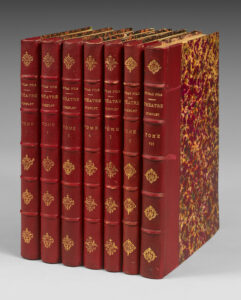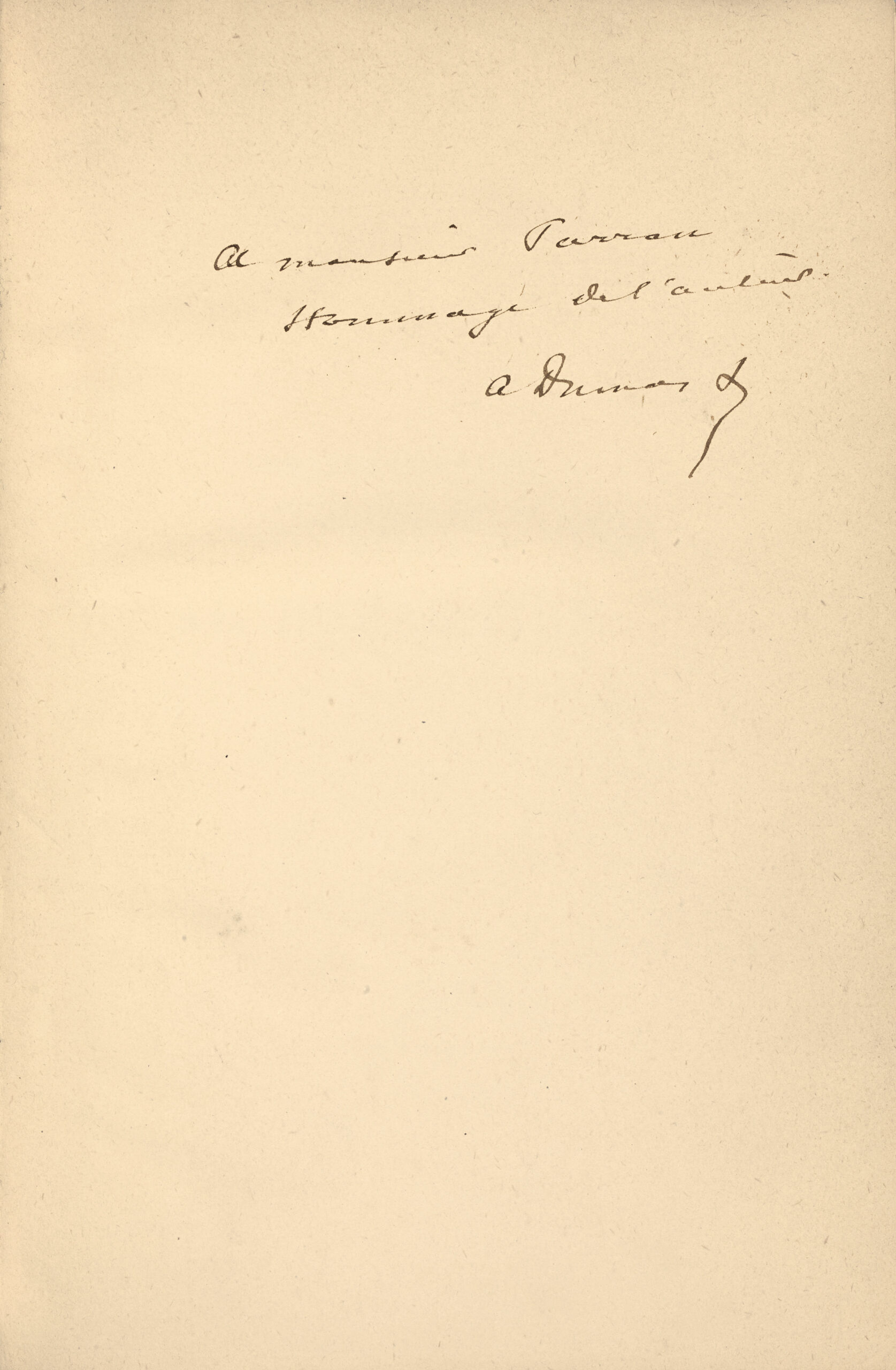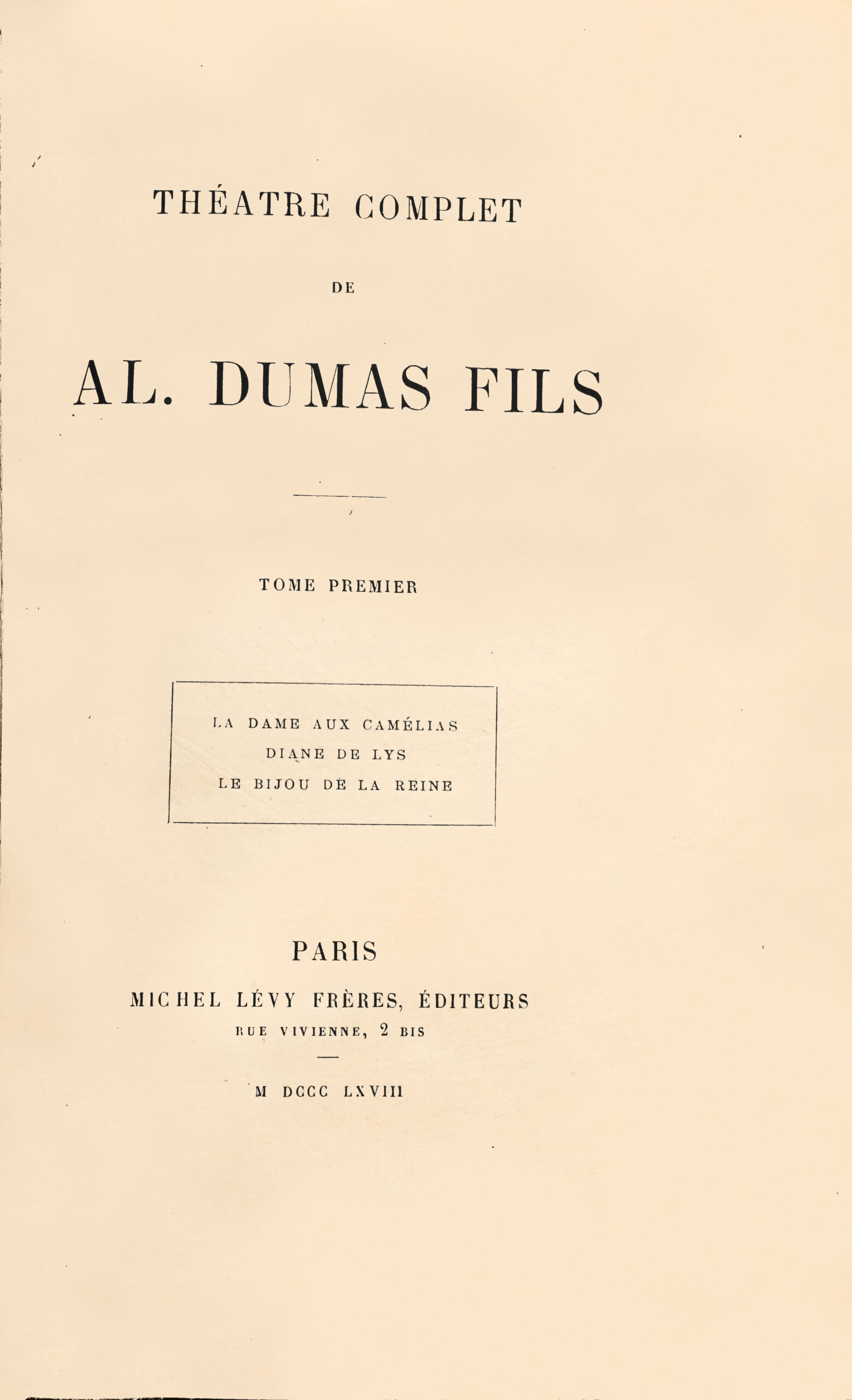Paris, Michel Lévy Frères, 1868-1892.
7 volumes in octavo, collated complete.
Bound in red half-morocco, with gilt top edges.
Contemporary binding.
Dimensions: 220 x 147 mm.
First collected edition, partially original, not commercially released, known as the “edition of friends.”
Carteret, I, 249; Vicaire, III, 487-488.
Only 10 copies were printed on China paper and 52 on Holland paper.
Precious copy on China paper, with an autograph inscription: ” A monsieur Parran Hommage de l’auteur. A Dumas.”
Son of the seamstress Catherine Labay, Alexandre Dumas fils was recognized by his father at age 7, but suffered from being a “natural son,” enduring ridicule from schoolmates and legal disputes between his parents. At 18, he plunged into a tumultuous and indulgent life, shared with many brilliant courtesans. Through bacchanals and alcove pleasures, he moved in dubious circles, where he mastered the one thing his father had taught him—debt. He excelled at it so well that he had no choice but to follow this path to the end. After publishing a volume of poetry (Péchés de jeunesse, 1847), he turned to novels, starting with Aventure de quatre femmes et d’un perroquet (1847), soon followed by La Dame aux Camélias (1848). Inspired by Marie Duplessis, the novel explored the romantic theme of a courtesan whom many lovers failed to teach true love; when she finally discovered it, she sacrificed everything, even her happiness, and sent her beloved back to the path of family and bourgeois society.
Following this brilliant success, rewarding and encouraging, Diane de Lys (1851) enjoyed a warm reception, but his later works (Trois Hommes forts, 1850; Le Régent Mustel, 1852) only gained moderate recognition. However, the stage adaptation of La Dame aux Camélias (1852) became one of the century’s most dazzling triumphs. From then on, apart from a few pamphlets presenting his theories (L’Homme-femme, 1872; La Question du divorce, 1880), Dumas fils devoted himself almost exclusively to drama. When La Dame aux Camélias was adapted into La Traviata, he became world-renowned—the first playwright to achieve prominence since the coup d’état. His moral comedy, blending passionate romanticism with social critique, lasted as long as the regime. Dumas fils strongly believed in theater’s power, aiming to warn audiences against the dangerous allure of the demi-monde, where aging libertines mingled with women whose husbands remained unseen. His plays depicted this world in its finest details, exposing Machiavellian deceit wrapped in lace and elegance, where innocence and naiveté could lose their way.
An advocate for redeeming seduced young women and children born from illegitimate unions, he refined his formula in his works (Le Demi-monde, 1855; Un père prodigue, 1859; L’Ami des femmes, 1864; Une visite de noces, 1871; La Femme de Claude, 1873), supplementing them with extensive prefaces. In Le Fils naturel (1858), he boldly declared: “Through comedy, tragedy, drama, or farce—whichever form suits us best—let us inaugurate the useful theater, even at the risk of hearing the apostles of art for art’s sake protest, three words utterly devoid of meaning.”
Includes a portrait of Alexandre Dumas fils, engraved by A. Legenisel, printed on China paper.
Autograph inscription signed by Alexandre Dumas to Parran, who noted: “M. Dumas a bien voulu m’écrire un envoi signé sur le feuillet de garde du 1er volume, en souvenir sans doute de la bibliographie de son frère dont je lui avais offert un exemplaire.”
Autograph letter signed by Alexandre Dumas fils (to Alphonse Parran) regarding this edition (undated, 2 pages in 12mo), along with a note by Parran (1 page in octavo):
*”First collected edition including all of Dumas’ plays except La Princesse de Bagdad.
Our copy is on China paper; I believe only five were printed.
It is known that the octavo printing of the first collected edition required a new composition and was exclusively reserved by M. Dumas for his friends and the actors who performed roles in his plays…
The author carefully revised the text of this edition and added the fascinating prefaces, which everyone has read and admired…
I consider this book, acquired in 1882 for 600 francs, as one of the most precious pieces in my collection of modern books.”* — Parran
The binder’s label (Charles de Haas) appears in volumes 5 and 6. The spine tooling differs across volumes (1–3 share one design, 4 and 5 another, while 6 and 7 each have unique motifs).
The cover and spine were preserved for volume 7.
Provenance: Jules Claye, printer (ex-libris); Parran (sale, 1921, No. 294).



